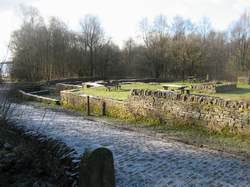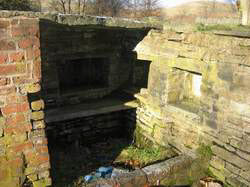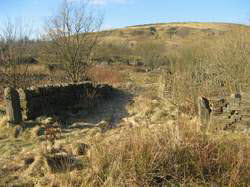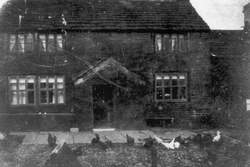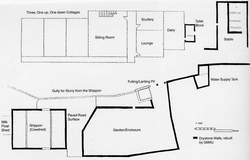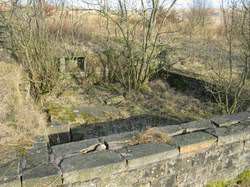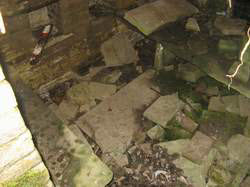Abandoned Communities ..... Rochdale Reservoirs
There was no school in the village, and the only shop was an informal one run in her home at 463 Ramsden Road by Esther Grayson. Children would have had to go into Wardle to attend school. Shopping would have been done in Wardle or Rochdale, with the Wardle Co-operative Store a popular choice.
Allen Holt has noted that very little is known about the reactions of people in Watergrove to the loss of their homes and community. There certainly appears to have been no organised opposition to the scheme to build a reservoir. As there were close links with the neighbouring village of Wardle it may have been possible for some people to move into Wardle. Apart from having to find a new home the process of resettlement may have been relatively straightforward. But for others, who may have lost their job at Watergrove mill or elsewhere in the valley, the transition may have been much more difficult.
On the website of the Wardle and Smallbridge History Group two interesting lists can be found. One is a list of all properties in the valley in 1929, together with the names of occupants and whether they were tenants or owned the property. The other is a list of properties compiled for income tax purposes in 1939 after the reservoir had been opened. From the second list you can see that most of the farms were demolished between October 1934 and March 1935, whereas most of the residents of the village did not leave until 1936 or the early months of 1937. The Orchard Inn presumably closed when the landlord John Stott left on 17 October 1936. A few places are recorded as still occupied in 1939, including Trap Farm (which continued to be occupied as it was south of the dam wall), and Littletown Farm.
Please get in touch with me if you have information about how any of the inhabitants of Watergrove coped with the move away.
At Littletown Farm the occupant at the end of 1939 was Jackson Crossley. He may have been particularly reluctant to move out of the valley, and I do not know when he eventually departed. You can see the remains of Littletown Farm if you walk around Watergrove reservoir today. It was in fact a small hamlet as the 1929 list indicates that four properties existed there, a house, farm buildings, and yard occupied by Crossley, and three cottages, each with its own outbuildings and garden.
Littletown Farm faced onto Ramsden Road, whose sett-paved surface can still be seen emerging from the reservoir and climbing the hill in the direction of Todmorden.
Roads Farm was another property whose ruins still exist. Dating back to the late thirteenth century it lay west of the village at OS SD905183. In 1929 it comprised a house, farm buildings, and a yard. Most of the farms in the valley were held by tenants, but Roads Farm had owner occupiers, James and Charles Clough. They must have moved away at a relatively early date, as the 1939 list records that the property was demolished in March 1935.
Roads Farm has been investigated by the Greater Manchester Archaeological Unit. In addition to those buildings listed in 1929 evidence of one to three cottages next to the main house has been found, together with stables, a shippon, and an enclosure thought to be a garden. If you explore the farm you may come across steps leading down into an underground cellar, possibly used as a cold storage space.
Allen Holt has noted that very little is known about the reactions of people in Watergrove to the loss of their homes and community. There certainly appears to have been no organised opposition to the scheme to build a reservoir. As there were close links with the neighbouring village of Wardle it may have been possible for some people to move into Wardle. Apart from having to find a new home the process of resettlement may have been relatively straightforward. But for others, who may have lost their job at Watergrove mill or elsewhere in the valley, the transition may have been much more difficult.
On the website of the Wardle and Smallbridge History Group two interesting lists can be found. One is a list of all properties in the valley in 1929, together with the names of occupants and whether they were tenants or owned the property. The other is a list of properties compiled for income tax purposes in 1939 after the reservoir had been opened. From the second list you can see that most of the farms were demolished between October 1934 and March 1935, whereas most of the residents of the village did not leave until 1936 or the early months of 1937. The Orchard Inn presumably closed when the landlord John Stott left on 17 October 1936. A few places are recorded as still occupied in 1939, including Trap Farm (which continued to be occupied as it was south of the dam wall), and Littletown Farm.
Please get in touch with me if you have information about how any of the inhabitants of Watergrove coped with the move away.
At Littletown Farm the occupant at the end of 1939 was Jackson Crossley. He may have been particularly reluctant to move out of the valley, and I do not know when he eventually departed. You can see the remains of Littletown Farm if you walk around Watergrove reservoir today. It was in fact a small hamlet as the 1929 list indicates that four properties existed there, a house, farm buildings, and yard occupied by Crossley, and three cottages, each with its own outbuildings and garden.
Littletown Farm faced onto Ramsden Road, whose sett-
Roads Farm was another property whose ruins still exist. Dating back to the late thirteenth century it lay west of the village at OS SD905183. In 1929 it comprised a house, farm buildings, and a yard. Most of the farms in the valley were held by tenants, but Roads Farm had owner occupiers, James and Charles Clough. They must have moved away at a relatively early date, as the 1939 list records that the property was demolished in March 1935.
Roads Farm has been investigated by the Greater Manchester Archaeological Unit. In addition to those buildings listed in 1929 evidence of one to three cottages next to the main house has been found, together with stables, a shippon, and an enclosure thought to be a garden. If you explore the farm you may come across steps leading down into an underground cellar, possibly used as a cold storage space.
Four
Littletown Farm
Storage area at Littletown Farm
Roads Farm
Plan of Roads Farm produced by the Greater Manchester Archaeological Unit
Roads Farm in January 2011
The dairy at Roads Farm
A cellar at Roads Farm
